Please View Sponsored Advertisements to Support this Site and Project
Migratory and other Birds in Bangladesh in Danger
Jamal Anwar
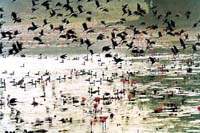 |
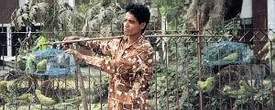 |
 |
One of Shakyamuni Buddha's former lives was as a bird and in the Jataka of The Four Friends, the bird says: "I must be older than any of you. When I was born I ate the fruit of a tree south of this spring. The seed of the nyagrodha passed through my body as waste, so I planted it."
A world sans birds and butterfliesFollowing the Rio Summit Conference of 1992, Bangladesh (represented by Mr. Noman, then forestry and environment minister in BNP era), along with many other countries, signed up the Biodiversity Agreement with the intention of checking and reversing the depletion of native plants and animals within the country and hence within the globe. Since that time not many areas in the country have seen Local BAPS (Biodiversity Action Plans) in place. To develop a crop plant, which is resistant to herbicides, is a further step along the road to agricultural monocultures. It hardly stands up to argument that killing the native weeds at a later stage in their life cycle is beneficial to wildlife. How would it benefit the goldfinches that feed on thistle seeds if these were killed sooner rather than later? How would it benefit the birds and tortoiseshell butterflies if they waste their resources by laying their eggs on nettles before their caterpillars are fully developed; more importantly, if a native plant is killed before it can produce seed, how long will it be before it is exterminated. Agriculture driven solely by the urge for profit will move inexorably toward monoculture but the countryside is more than a base for food production. It belongs to us all and there are those who fought and died for it.Should we then develop a world where no birds sing and no butterflies fly in order to put money into the pockets of a few? (Ghulam Murshed, November 9, 2003). |
How does the strange bird
flit in and out of the cage,
If I could catch the bird
I would put it under the fetters of my heart
....................................................................
O my mind, you are enamoured of the cage;
little knowing that the cage is made of raw bamboo,
and may any day fall apart
Say Lalon, forcing the cage open
the bird flitted away, no one knows where (Lalon Song).
.
The village birds return home after playing
on the sand bank.
The birds on the sand bank are continuously crying. ( Jasim Uddin)
Tuntuna and Tuntuni
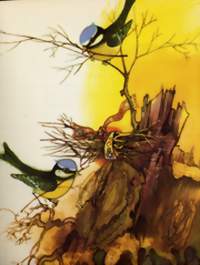
"Tuntuni, we have become rich!".....
They were so happy that they forgot about eating and sleeping. They just danced and singing:
"How much money does the king have?
That's how much money we have"
....When the king heard the words of the birds and made him very angry and ordered to catch them immediately.....
The commander of Chief at last with the help of the fishermen caught the birds.
The king gave the birds to his 101 queens...The birds were passed from one queen to another. The lazy queen did not hold the bird tightly, and first Tuntuna then Tuntuni flew out of her hands.....No one of the queens dared to tell the king what had happened.
... The next day, the king call all the wise men in the land to his court to judge the Tuntunis...
The king ordered the birds to be brought into the court. He waited and waited, but the Tuntunis did not come....
Suddenly, the Tuntunis came flying over the king's head.. and singing:
"Tuntuna, Tuntunni,
Tuntunis tun tun!
All the queens noses
Are as red as roses!
Tun tun, tun tun, tun tun."
The king could control his anger. "Catch those Tuntuni bird," he shouted....
 Soon the two birds were caught in the nets, but this time the king would not wait for his wise men to judge them. He took a glass and swallowed tuntuna and tuntuni.
Soon the two birds were caught in the nets, but this time the king would not wait for his wise men to judge them. He took a glass and swallowed tuntuna and tuntuni.
The wise men shook their heads. One of them said to the king's first minister, "The first time the king laughs the Tuntuni birds will fly out of his mouth."
So the first minister ordered a soldier to stand on each side of the king. He said, "When the king laughs, the birds will fly out of his mouth .. You must cut off their heads with your sword as soon as you see them."
Just then one of the queens came to talk to the king. She was the queen who was always laughing. When the king turned to speak to her, the queen began to laugh. Of course, the king has to laughs too.
As soon as the king started laughing the Tuntunis flew out of his mouth. "Zing Zing," went the soldiers swords, but they did not catch the birds. Instead of chopping off the heads of the Tuntunis, the soldier had chopped off the nose of the king. Tuntuna and tuntuni flew round and round the room, singing:
"Tuntuna, Tuntuni
Tuntunis tun tun!
The nose of the king,
Was cut "Zing zing zing"!
Tun tun, tun tun, tun tun."
(From The Folk Tales of Bangladesh by Jasim Uddin)
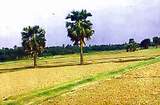 "I'll fly to you like a bird !" thousands of years the love and passion for birds rooted in the society. but since independence plenty of arms are scattered all over the country. I was shocked to see how a few rural people kill bird just for fun or picnic. Many rich from the cities visits wetlands of Bangladesh during winter months well equipped with modern weapons just to kill migratory birds for their kitchen pots. The most shocking event is that when I saw school age children killing birds. They prepare small fishes treated with a poisonous pesticde locally named "Furan" (Carbonfuran is a banned pesticide) and lay near water bodies. When the bird eats the fish immediately die. A young boy was narrating me excitedly, how he collected 50 birds. This is painful at the same time disgusting. Where are the values of our life? Most people does not listen poetries, songs, folk tales that communicated values of our life since thousands of years but have enough time to watch or listen imported films, songs and the culture of the elite of the society through TV , radio from morning to dawn.
"I'll fly to you like a bird !" thousands of years the love and passion for birds rooted in the society. but since independence plenty of arms are scattered all over the country. I was shocked to see how a few rural people kill bird just for fun or picnic. Many rich from the cities visits wetlands of Bangladesh during winter months well equipped with modern weapons just to kill migratory birds for their kitchen pots. The most shocking event is that when I saw school age children killing birds. They prepare small fishes treated with a poisonous pesticde locally named "Furan" (Carbonfuran is a banned pesticide) and lay near water bodies. When the bird eats the fish immediately die. A young boy was narrating me excitedly, how he collected 50 birds. This is painful at the same time disgusting. Where are the values of our life? Most people does not listen poetries, songs, folk tales that communicated values of our life since thousands of years but have enough time to watch or listen imported films, songs and the culture of the elite of the society through TV , radio from morning to dawn.
 At one time agricultural fields were surrounded by scattered plantation with palm and date trees which not only gave fruits, absorbed excess nutrients by agriculture but also gave shelters to birds who use to prevent the spreading of insects that destroys agriculture. Now these trees are just disappeared. All of a sudden palm woods become main source for wood work although the quality is very poor for such works.
At one time agricultural fields were surrounded by scattered plantation with palm and date trees which not only gave fruits, absorbed excess nutrients by agriculture but also gave shelters to birds who use to prevent the spreading of insects that destroys agriculture. Now these trees are just disappeared. All of a sudden palm woods become main source for wood work although the quality is very poor for such works.
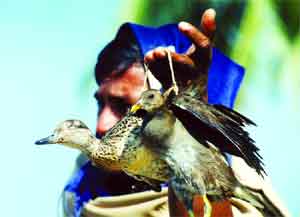 |
A man sells exotic birds at the Aricha ghat Friday.(December 9, 2004) Despite a ban on their poaching andsales of wildlife, the birds still end up on the dinner table (New Age, January 10, 2004) |
Winter is the king of all seasons in this tropical land. The equivalent of spring in the temperate countries. It is ideal for the blooming of life, what scientists call bio-synthesis. As global interest veers from the material sciences to life and the environment, the Bengali winter gains in importance. Scientists want to preserve the biological diversity of the world, as much as possible before people destroy it.
In winter Bangladesh witnesses the arrival of millions of migratory birds, every year from Europe on their way to Australia, Indonesia and Vietnam. The most important identified flyway in Bangladesh is the Meghna estuary-areas around the offshore island of Hatiya.
The donor community in Bangladesh has also suggested a number of measures for protection of the environment of which the coastal zone management (CZM) is the largest and most important.
Globally the nesting grounds of birds- the wetlands- are being protected by the Ramsar Convention. Bangladesh is also a signatory to this convention and as such has an obligation to protect these sites. There are three Ramsar sites in Bangladesh-The Meghna estuary, Tanguar and Hail-Hakaloki Haors. The latter two are in the north-eastern district of Sunamganj. But you can not protect bio-diversity by signing or helding workshops or conferences in five star hotels while forgeting to reintroduce traditional values.
The State of Birds in Bangladesh
There are about 207 species of bird live or visits Bangladesh.Among the birds 30% are waterfowls, 26% waders, 20% bush and her bland birds and the rest are grassland, air hawking prey. Of these fresh water bird 129 species (62.3 %) are resident and the other are migratory.
Extinct wetland birds: Spotbill pelican, Pelican, Scavenger Vulture, Bengal Florican, pinkheaded Duck, Greater Adjutant, King Vulture (IUCN, 1993).
Endangered birds: Poceps cristatus, Phalarocorax carbo, Anhinga rufa, neophron percnopterus, Leptoptilos javancus, plegadis falcinellus, A. anser, Carina scutulata, Haliaeetus leucoryphus, Anthropoidis virgo, Rostratula bengalensis, Esacus magnirostris and Palargopsis capanesis (IUCN, 1992).
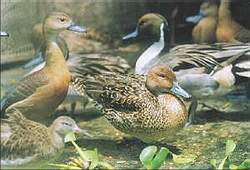 |
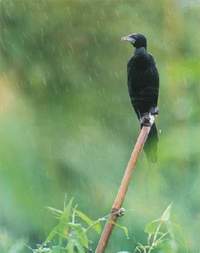 |
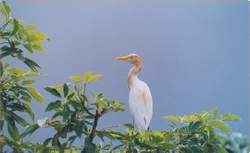 |
Poachers engaged in hunting wildlife this year round, as migratory birds have flocked to marshlands and water-bodies with winter stealing over the country. Although the wildlife preservation act prohibits hunting migratory birds and wild animals, the law is not being implemented. Open sales of wild and migratory birds by traders all over the city have become all too flagrant. Officials blamed the laxity of the anti-hunting drive on lack of manpower in the wildlife conservatory section of the forest department. One of them cited unawareness as another reason for the rise in wildlife captures. The law imposes punishment of a six-month imprisonment, which can be extended to a year or a fine of up to Tk 1,000 or both, along with confiscation of firearms, vehicles, vessels, watercrafts, appliances or any other tools used in hunting.
Although the government had the provision to permit area-specific shooting and hunting of certain species, a ban was imposed on it five years ago to protect ecological balance. With the ban coming to an end this June, a decision at an inter-ministerial meeting on October 16 said the ban would continue indefinitely, a forest department official said.

People are still unaware of the importance of migratory birds and the global ecological balance they make," he said. "The sale of these birds is patronised by rich urban dwellers."
"They are the largest group of wildlife customers. They await the opportunity of purchasing the hunted birds or animals to make them delicious meals. There should be a law against the consumers too, which will result in the protection of wildlife," he said.
The places where the guest birds gather are Pilkhana, Dhaka National Zoo and Botanical Garden, Bangabhaban compound, Ceramic Lake (Mirpur), Jahangirnagar University and water-bodies around the city. The water-bodies in Dhaka are now polluted, disturbed and unsuitable for migratory birds. "Last year no birds were found in the Botanical Garden Lake as there were no enough weeds for them. Day by day people are destroying the water-bodies and making them inapt for wildlife," the official said.
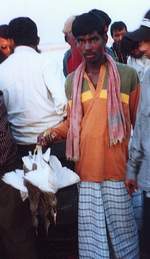 The spots where birds sell in the open are in Dhaka Elephant Road, New Elephant Road, Farmgate, Manik Miah Avenue, Asad Gate, Satmasjid Road, New Market, Banglamotor, Maghbazar, Mahakhali and Gulshan.
Guest birds trapped in Sylhet's haors are held captive in Srimongal town for sale in other cities.
The spots where birds sell in the open are in Dhaka Elephant Road, New Elephant Road, Farmgate, Manik Miah Avenue, Asad Gate, Satmasjid Road, New Market, Banglamotor, Maghbazar, Mahakhali and Gulshan.
Guest birds trapped in Sylhet's haors are held captive in Srimongal town for sale in other cities.
The Independent on 16th December 2003 reports:
With their arrival some greedy people have become active in catching the guest birds for making money. Some people have taken bird hunting as their profession for the time being. They are using huge nets of fine yarn for catching the guest birds. They set their nets across the water bodies at night and collect the netted birds early in the morning. Then they bring the birds to different markets and sell those at various prices according to their size and taste. They sell the big birds for Tk. 200 to Tk. 300 each. The medium sized ones are sold for Tk. 80 to Tk. 60 per piece. The members of the law enforcing agencies are among the buyers. It is extremely ironical that despite standing rules favouring punishment against hunters of guest birds, absence of enforcement of the rules encourages the bird hunters instead of creating fear of punishment. They are reported to have been keeping the law enforcers mum by bribe and gift of birds, it is alleged.
The Daily Star in an editorial decribes (November7, 2003):
There are many oddities in and around the busy traffic intersections of Dhaka that we have taken in stride, but not perhaps the crude hawking of migratory birds with the startling 'Ei Shikar' calls. So wily the vendors have become that while displaying the deshi variety as a decoy they lead intending buyers to where the migratory birds have been surreptitiously kept.
The Daily Observer (December 20, 2003) reports from Mymensingh :
The indiscriminate hunting of guest birds is continuing in the haor and hilly areas of Netrakona district since the begining of Winter this year but none is to look into the matter.
Like previous year, thousands of guest birds arrived in haor areas of Khaliazuri, Mohangonj, Madan and Atpara upazilas and the hilly areas of Durgapur and Kalmakanda bordering upazilas. There are different ways of hunging the guest birds. Some hunters use gun who are mostly influential persons of the society. They are hunting the brids in connivence with local administration. Some of the hunters mostly professionals are using cages to catch the birds. They also apply a number of methords to easily net the guest birds.
Thus the sale is sometimes open and, at other times, a concealed affair. But there are reasons to believe all this is happening under the very nose of the law enforcers. A class of dishonest traders and vicious trappers are in the business. The forest authorities have the generalised Wildlife Preservation Act of 1974 to deal with the situation which has its own ramifications in respect of migratory birds as compared with other kinds of wildlife
By the dictates of Nature, Bangladesh is a sanctuary for migratory birds in the winter season. Their habitats and foraging grounds lost to icy cold up in the Siberian North, these beautiful objects travel to a warmer clime like that of Bangladesh. They get a plenty of food and a sustaining environment here. With the first intimation of spring in Bangladesh, they will have flown back to Siberia to breed and procreate. Experts estimate that 250 species of such birds migrate to Bangladesh during winter suffusing the environment with colour and warbling sounds. While enhancing the beauty of nature by their delectable presence, they enrich bio-diversity of nature striking a balance in the ecology.
When so much is at stake, the trappers and sellers of the birds must be brought to book. The most effective deterrent to the business will come from public awareness of the environmental degradation it causes. Let's build public opinion against hunting, trapping, killing and eating of migratory birds so that such criminal offences are fended off.
700 species of birds in Bangladesh - half are migratory
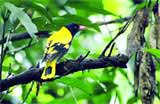 Bangladesh has some 700 species of birds nearly half of which are migratory in one form or another. Hardly these birds form any large congregations excepting those that visit our wetlands -- haors and beels as well as our coastal areas and the Kaptai Lake during the winter months. These are all migratory birds.
However, recent sighting of a large colony of birds in the village Pochamaria under Shilmaraia Union of the Puthia thana in Rajshahi is no doubt a remarkable find. This heronry is possibly the largest one in the country outside the government reserved forests in the Soondarban and the greater districts of Sylhet and Mymensingh.
Bangladesh has some 700 species of birds nearly half of which are migratory in one form or another. Hardly these birds form any large congregations excepting those that visit our wetlands -- haors and beels as well as our coastal areas and the Kaptai Lake during the winter months. These are all migratory birds.
However, recent sighting of a large colony of birds in the village Pochamaria under Shilmaraia Union of the Puthia thana in Rajshahi is no doubt a remarkable find. This heronry is possibly the largest one in the country outside the government reserved forests in the Soondarban and the greater districts of Sylhet and Mymensingh.
As I have gathered Pochamaria has turned into a Heronry about a decade back when a small flock of Cormorants started roosting at first and then started breeding in the area later on. This Heronry is supported by a few bamboo clumps within the compound of a few villagers by the side of Pochamaria Bazar and the local road that links Taherpur. Some birds, especially Asian Openbill or Shamuk Bhanga, roost on a few Shimul trees (Bombax ceiba) within half a kilometer of the market.
The beauty of Pochamaria people is that for some reason they have become tolerant to the hell of a lot of trouble created by the resident Cormorants -- the Pankowris and Herons (Bok). First and the foremost negative impact resulted from the faeces of these birds that are systematically killing the local cash-crop such as the bamboos and Shimul trees. Positive impact of these faeces is that these naturally manure the fields and ponds where various crops and fish are cultivated.
In addition to birds there are over 1000 Badur, Flying Fox or Large Fruit Bat (Pteropus giganteus) that use the area for roosting. They use the same bamboos and Shimul trees for daytime roost and make hell of a racket by continuous chattering and squeaking. Some visitors even confuse this as 'a kind of bird'! Bats are mammals like us and produce babies that drink mothers' milk and their bodies are covered with hairs. Birds on the other hand produce eggs and chicks hatch out of these. Their bodies are covered with feathers. Unlike Chamchika or Insect Bats that are purely nocturnal and move by echolocation, not by vision, Fruit Bats have large eyes and can also see in daytime.
Birds of Pochamaria, including the neighbourhood of the Heronry Birds in the Heronry Proper
Birds included in the list below are found in and around the Heronry at Pochamaria. These are organized in order of commonness, not on systematic. Bengali name of each species is followed by the English and then the scientific or zoological names.
Source: Holiday, R. Khan, August 18, 2006
The dark side
As the cars stop at the signal, a scruffily dressed man carrying rushes and egrets, rush by the open windows, stretching his hands and showing birds for sale. Some in a bid to bring variety at the dinner table buy the birds meanwhile others, too pre-occupied with themselves, just wave the man away. A common sight in the city, especially in winter and year in year out this is being enacted without hindrance. Given our unanimous support for wildlife preservation and our so called concern for better treatment of wild species of birds, this act of selling migratory birds goes on, unabated and to a large extent unlamented. In fact, our interest to save natural flora and fauna faces a large question mark. Yes, the environmental organisations do bring out regular processions and submit memorandums but the result of their actions has been pathetically minimal.
In this regard we are compelled to look at the massacre of birds at Hakaluki Haor, Moulavibazar a year ago. In January last year, around 30,000 birds were poisoned to death at the Haor and as the news of this killing spread a massive outrage took shape. Pro-environmentalist bodies took out processions, conscience citizens became vocal and a four member enquiry team was formed. Though there were several reports on the situation at Hakaluki, gradually, as summer set in, the hullabaloo died down and till this moment we are unsure who were behind this deed and why. There have been sketchy attempts to provide answers but fairly said, the killing of the birds has gone unpunished. A year later, in another winter, we still hear birds being killed and caught to be sold in the open market. The ‘Ai Shikar’ phenomenon may seem harmless on the surface but its acts like these which indirectly condone the killing and catching of birds. Paradoxically, bird sellers are common sights on the roads along with reports that denounce the killing of birds, but pro environmentalist bodies do not realise that the first step should be to ensure that these sellers are caught, punished and deterred.
adly, in Bangladesh pro-wild life moves are based mostly on rhetoric and very little action. The Rash Mela can provide a good example in this context. The traditional fair held near the Sunderbans is popular because every year, venison sold here is a major attraction; the act may be illegal but it goes on unabated. It is also alleged that poachers hire guns from local political leaders to kill deer and sell their flesh in the market. Later, the venison is sold between Tk 80-Tk120 per kg.
Coming back to the issue of birds, they are trapped and killed not only is specific areas but all over the country. Obviously, to stop this, more concrete actions apart from processions are necessary and along with this there has to be a massive public awareness programme. This winter, several newspapers have carried reports as well as editorials to state that guest birds should not be killed but their pleas have reached only the educated class and considering the fact that people near the haor and bil areas are uneducated, there should be a grass root level attempt to inspire a pro-wild life attitude. At a very reasonable cost the government can carry out pre-winter campaigns in the haor areas and the relevant ministry can employ a seasonal force to ensure that guest birds return home safely.
But, it would be wrong to state that in Bangladesh there aren’t any place where birds are safe from harm. There have been reports that at Kanglar Haor in Sunamganj, guest birds are neither shot nor caught. Near the Haor is the Birampur village, where people understand that as part of Mother Nature guest birds need to be cherished not hunted.
The local Panchayet in this village banned the killing of birds about six years ago and today the Kanglar Haor and its vicinity is a haven for winged guests. The initiative to save birds was taken by Abdus Samad, an elderly villager and now his step has proved to be a united move worthy of replication. A similar committee blessed by the local authorities of areas where guest birds come can help add impetus to our overall pro-environmental stance(T. Feroze, Holiday, January 20, 2005)
Sweet twittering of migratory birds will perish
The lakes inside the Jahangirnagar University (JU) campus near Dhaka, traditionally a paradise for migratory birds escaping from Siberian and Himalayan cold, have been the aesthetic symbol of the country in contact of red lily with thousands birds surrounding with red ceramic buildings of the university. Hundreds of visitors wing to the JU campus to rhyme their lips with the sweet twittering of the guest birds and to breathe in fresh air of the university everyday.In total of 697 acres of the ever green JU campus, 200 acres are covered with 20 lakes and ponds. The lakes infront of the University Registrar building and the lake beside the Jahanara Imam Hall and Pritilata Hall are especially the moving place for the birds. The birds begin to come here in September every year and stay till March-April.
Experts believe that, though it is said that the birds come from Siberia, but they mainly come from Himalayan region and from north of India like Tripura, Assam. For this sigh of ecological habitat, the birds are terminological called local migrant. Experts also say, 95 per cent of the migrant birds are lesser whistling duck, a black long throated bird which is known in our country as small sharali hash. Except this Pin Tail locally known to us as Lenza, Cotton Chil, Common Chil, Germany and spot billed duck are also seen among the local migratory birds.
Among the birds coming from Siberian, "Wader" group are specially utterable. This is similar to Kadakhocha of our country, JU experts say.There would come 25/30 species birds on the campus but it has reached almost half now. The birds, which have used the lake area as a resting ground, have been restricted to the few remaining lakes. This correspondent spoke with bird expert of the university AHM Ali Reza, who told me that, about 8,000 to 10,000 birds would come on the campus just 5 year ago, but now the number has came down to 3,000 to 4,000 only.
Ecology becoming unfit for birds
Mr Reza, who is also the lecturer of Zoology Department of the university, also expressed that the birds will not come following 4/5 years because of ecological unfitness of lakes. Now the depth of water in the lakes is 1/2 feet and these would be filled up with silt if it was not dredged as soon as possible. Jahangirnagar University is included in the Madhupurshall tract zone of the 12 ecological zones of the country. Soil filling rate is more in the zone, he added.
Ten lakes out of 19 were leased by the university authorities for commercial fish cultivation that posed a great threat to the ecology of the outlying JU area, and it saw a massive protest from the students and concerned persons of the university then. It is alleged that a section of officers, employees and teachers of the university would make money from the fish cultivation project while JU earned only Tk 5 lakh a year from the leased lakes. However Nature Study and conservation Club (NSCC) was formed following the fish cultivation
AHM Ali Reza said "some species of fish like the carps dig up the lake bed causing land erosion". Lakebed thus loses its capacity to absorb dirt and other water pollutants, he added. Fertiliser such as TSP, Urea and Lime used for fish cultivation increases the ratio of nitrogen and decreases Oxygen dissolved in water. Coupled with failure to dredge the lakes for years, the process contributes to serve pollution of the stagnant water (Bangladesh Observer, November 26, 2004).
Have guest birds stopped coming to Durga Sagor, Barisal, S. Bangladesh?
Have guest birds stopped coming to the historic Durga Sagor Dighi (wetland) in Barisal? Local environmentalists say so. Durga Sagor is a famous sanctuary for guest birds coming from Sibera and Europe to escape chilling cold. In earlier years, the birds usually started flying into the spot from September and stayed till March.
But this year, no guest bird is still seen there.Change in the environment and sound pollution is the main cause of absence of guest birds there this year, local environmentalists said. Noise of the nearby airport, busy highway, mike of mosques create sound pollution in the area regularly.
Where are all the birds? Startling new figures on rate of extinctions say 12% of species to be in peril by 2100. The world's birds are disappearing in greater numbers than previously calculated, and the number of extinctions will grow even more dramatically by the end of the century, according to a grim study published today in the journal Proceedings of the National Academy of Sciences.
The study, the most thorough analysis of global bird species, says 12 percent of existing species -- about 1,250 -- are threatened with extinction by 2100.
Up until now, scientists had documented the extinction of about 130 bird species since the year 1500. But the study's authors -- from Stanford University, Duke University and the Missouri Botanical Garden in St. Louis -- say the more accurate estimate is about 500 extinctions out of more than 10,000 known bird species. That would be about one extinction per year over the last 500 years.
And that rate is 100 times higher than what was considered natural before human influence, the study said.
Over time, humans have cleared land for agriculture and other uses. They've hunted birds for food and sport. And they introduced other dangers, such as non-native birds, rats, snakes and diseases. |
Los of Wetland
The wetlands (haros, baors, beels etc.) are concentrated in the following physiographic units (Huq and Kamal, 1993):
- Lower Atari Basin : It occupies a low-lying area between the Barind tract and the Ganges river floodplain. The basin area receives floodwater from the Atari and the Jamuna rivers and from the Ganges distributaries. Flooding formerly was very deep and large areas ( in Chalan Beel ) remained wet through dry season.
- Lower Punnarbhaba Floodplain: This unit occupies a narrow strip of floodplain land along the lower course of the Punarbha river in the west of Nagaon and the north of Chapai Nawabganj districts (north-west Bangladesh).
- Gopalganj-Khulna Beel: It occupies a low-lying area between the Ganges river floodplain and the Ganges tidal floodplain. The basin centres lie almost at sea-level and characterised by one or more peat layers . C14 dating indicates the age of the peats as between 200 and 3000 years deposited on an older tidalflat.
- Arial Beel: It occupies a low-lying basin between the Ganges river floodplain and the young Brahmaputra floodplain in the south of Dhaka district. The Arial beel clays often include buried organic layers and have a rather peat topsoil in permanently wet depression.
- Surma-Kusyara (Syleht Basin) Floodplain:The meander flood plains of rivers include the upper Meghna,Surma, Kusyiara, Manu; Dhalat and Khowai etc. flowing from Shillong plateau included in this unit. It mainly comprises extensive, low-lying basins(the harors) bordered by relatively narrow ridges.
- Akhaura Terrace: It occupies eastern border small patches along the eastern border of Brahmanbaria district. It is shallow to deeply flooded during rainy season.
- Floodplains(Physiographic units 3, 6, 7c, 11a, 12c): The floodplains have formed in river and piedmont alluvium ranging from very recent to several thousand year old.
The Ata Danga Baor, in the Padma floodplain, supports a number of endangered species, which are almost extinct. The Chalan Beel, considered to be one of the largest wetlands of Bangladesh, now covers only a quarter of the 100,000 hectares that it covered 150 years ago. If the current trend continues, in twenty years about 2 million ha of flood plains would have been permanently removed due to flood control and drainage development, amounting to an estimated net loss of 73,000 to 110,000 tonnes per year from inland fishery (Ministry of Environment and Forest, 1991). In the planning projects farmers' requirements and knowledge are not considered . Mainly engineers' decisions and designs are imposed on them. For example, under the Ganges-Kobadak Irrigation Project construction of flood embankments turned flowing rivers like Kumar, Kaliganga and Dakua into dead rivers which created serious ecological disaster. Another example of ecological disaster is Horai River Sub-Project where in February 1989 in inlet of the Horai River at the Padma(Ganges) end closed down which resulted in drying up of 20 beels(wetlands) of 9,000 acres.
Chalan Beel in Pabna and haors in Sunamganj are the areas from where the local migratory birds fly to Dhaka, and birds also come from most winter-prone countries like Siberia and Russia. Among the birds that migrate from abroad and local areas are lesser whistling teal, pintail, poachard and some other resident birds including egret, heron, duckling, darter, stork, little cormorant, dove, swan, white-breasted water hen and moorhen
|
AGROCHEMICALS : IMPORTED POLLUTANTS IN BANGLADESH
"Habitats of birds are gradually being reduced due to various reasons including depletion of forests, change in natural vegetation, use of pesticides and insecticides, plantation of exotic trees and human interference," they said. They especially favoured the youth community to play a positive role in conserving the natural heritage side by side with dedicating themselves in the study on birds and conservation of nature, eco-tourism and rural resources development.
BSS reports from Netrakona : Migratory birds, our majestic avian guests in winter, have started flying into the downstream areas of Khaliajury, Madan and Mohanganj upazilas of the district. The entire area was resounding with the chirping of winter birds. Some migratory birds were seen gliding in the blue sky, some were wading across the banks of the haros, baors, beels (wetland) and canals and other water bodies and catching small fish from the water. Others were seen chattering or sauntering on the shoals.
Talking to correspondent, local people said during the last few years, the number of migratory birds has been reduced to two-thirds because of rampant killing of the guest birds and scarcity of small fishes in the water bodies. They also observed that a section of professional bird-hunters catch the guest birds everyday for selling in local hats and bazars. Besides, the greedy meat eaters are also trapping the migratory birds creating a sense of insecurity among the guest birds, they said.
Local people from different walks of life had drawn the attention of the government to ensure safe stay of these guest-birds in their temporary winter homes in the downstream areas of the district.
Guest Birds, EditorialFood of the birds is also becoming scarce due to increased use of pesticides and chemical fertiliser in agricultural lands. Lack of awareness among people about preservation of guest bird sanctuaries could be another cause of the absence of migratory birds this year, they said. Officials have also not taken any step in this regard, they said. Nature-loving people and tourists are also gradually loosing attraction of the historic Durga Sagor as the bird sanctuary Not a single bird has so far arrived in Durga Sagar which is one of the famous sanctuaries of migratory birds in this country. Wanton poaching coupled with a few other hostile circumstances is said to be the cause. A few birds which did reach were scared away by the blasting of crackers in the area on Shab-i-Barat and on Eid day. And because of indiscriminate use of insecticide pests are being destroyed robbing the birds of their natural feed. Also noise of the nearby airport and bustle on the highway have affected the serenity of the place. But here one must add that the site for the airport should have been planned more carefully, since the sky over the airport is kept free of birds. In the recent past it has often been reported in this newspaper and the other media that the country's wetlands are disappearing. If the birds do not arrive the country loses nothing in practical terms but it takes away much from the beauty and splendour of the country. And if the environment is becoming hostile to birds it does not mean it cannot long remain friendly to man. The lakes and wetlands are indispensable parts of a country's natural bounty. Owing to the inordinate pressure of population the lakes and wetlands were no more safe than the forest lands. But it is not only the number but the behaviour of people also matters. If the people were made more aware about the environment and learnt to live in harmony with nature, the natural assets could be sustained. Public education together with conservation must be given a new thrust. (The Daily Star, 6. 12. 03). Guest birdsDetermined efforts needed to save them Now that school children have joined the chorus, cursing the killers of migratory birds, the unkind fellows engaged in the cruel business should show a greater sensitivity to the issue. They must feel guilty.Guest birds fly all the way from frosty zones in search of light, warmth and food and a huge number of them used to land in this country in the past. But they often find their winter habitats infested with poachers. Indiscriminate catching of such birds has been going on despite a government ban. It is not at all clear why enforcement of the law in this respect is so lax. These birds are often seen dangling at an absurd angle in the hands of remorseless sellers in the city streets, under the nose of law enforcers. They find buyers too as many people are still not aware of the damage they would be causing to the environment by eating up the beautiful creatures. It is a disgrace to the errant adults that they do not understand what the school-going minors do. The law enforcers must not allow anybody to sell birds in the city as the first step towards protecting the guests in peril. Then poaching and hunting must be stopped to create safe sanctuaries for the visitors coming from far-away places. It is not enough for some bird lovers to raise their voice against poachers. People in general must feel the need for saving the birds -- an integral part of the living world and nature. That is how a social movement against poaching can gain momentum. The law must not remain silent amid the ruthless slaying of guest birds. The countries lucky enough to receive the guests have hardened their resolve to save them from the hands of poachers. But we are not giving anything beyond a nonchalant and routine lip-service to their cause (Editorial, The Daily Star, 7. 12. 03).. |
Nilsagor no more attracts guest birds
Asaduzzaman, Nilphamari (December 27, 2003) reports:
The birds used to start arriving from early November and stayed till March-April. Their chirping on trees, dips in the clear water movement in large flocks thrilled hundreds of visitors from home and abroad. |
Illegal wild bird sellers on streets, again, 2004
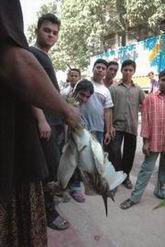 Poor enforcement of the Wildlife Preservation Act of 1974 banning the hunting of wild waterfowl threatens the survival of certain globally threatened species and hinders Bangladesh's rich biodiversity.
Every year, starting from mid-November, countless numbers of wild ducks and herons are sold for consumption on the streets of Dhaka. This is peak time for commercial wild bird traders looking to trap and sell these birds for high prices in the cities.
There is a big market for wild waterfowl in the capital where a single bird can fetch up to Tk 500 (6 US Dollars).
Poor enforcement of the Wildlife Preservation Act of 1974 banning the hunting of wild waterfowl threatens the survival of certain globally threatened species and hinders Bangladesh's rich biodiversity.
Every year, starting from mid-November, countless numbers of wild ducks and herons are sold for consumption on the streets of Dhaka. This is peak time for commercial wild bird traders looking to trap and sell these birds for high prices in the cities.
There is a big market for wild waterfowl in the capital where a single bird can fetch up to Tk 500 (6 US Dollars).
Wild waterfowl are generally sold on the street outside the legitimate market places, with their feet bound, held upside down. They are mostly traded in the evening on Elephant Road, Nilkhet, Katabon, Moghbazar and Purana Paltan. Occasionally a rare bird is sold by wildlife vendors for consumption as they are unaware that the bird could be in the international list of endangered species. However, little is being done to stop this illegal practice.
The Department of Forestry is not enforcing the Wildlife Act, although it is their job to escort police in catching wildlife crime offenders," says Munjurul Khan, an expert of World Conservation Union (IUCN). The police are not trained to identify wild birds and are therefore ill equipped to handle the problem without support. The absence of government initiative is further evident by the fact that the Wildlife Act in question has not been updated since its enactment 30 years ago. The highest penalty fine in the Act amounts to a meager Tk 500.
"We need to take away their (bird sellers) means to a livelihood which is dependent on selling wild animals," says Munjurul Khan. Three of the most globally threatened waterfowls that pass through Bangladesh during the winter are the Baikal Teal, the Ferruginous Duck and Baer's Pochard.
Ducks are usually caught by nets in the wetlands of Sylhet and Srimangal and in coastal areas of Monpura, Nijhumdeep, Boyarchar, and Chorpia. Munjurul Khan recalls capturing 500 wild birds from a commercial vendor, who later admitted bringing them for selling to a renowned politician. Among the bunch were two Baikal teals.
The commercial trapping of wild birds are at their highest from November to February, when thousands of birds, primarily ducks, arrive from the north on their way to warmer climates. Bangladesh is one of the most important locations in the world for these birds as two major migratory routes traverse it: the East Asian Austral-Asian Flyway and the Central Asian Flyway. According to Wetland International's census last year, about half a million migratory birds passed through Bangladesh last year.
The only protected wetland in Bangladesh is Tangaor Haor, which was declared an officially protected site four years ago. Nationwide commercial trading of ducks began in the early 1980's as cities began to develop. The further the point of capture from where it was being sold, the higher the price, which is how Dhaka became a popular destination for the illegal bird trade. Surprisingly, the Department of Forestry's priorities are closer to those of the self-serving poachers than they are of conservationists.
"The department does not have a pro-conservation objective, but rather an objective to abstract revenues," says a forest department official. Another official of the department claimed that commercial trapping was not a threat on the survival of bird species, emphasising instead on the deterioration of natural habitat and overcatching of fish as the dominant threats.
"There is no organised poaching of birds, only sporadic killing," claims the official. "Besides, if one duck gets stuck in a net, all the other birds will avoid the trap," he added. Sajedul Islam, an ornithologist at IUCN, believes otherwise. "The pintail is the most hunted migratory bird and also the most widely sold in Dhaka as they tend to be large in size."
There is a debate among experts on whether or not there is a significant presence of migratory birds among the lot of wild birds sold for consumption. But most agree that, migratory or not, the survival of certain wild ducks is threatened by mass bird hunting for the purpose of trade. Asked why the Department of Forestry is not going to key duck selling locations in the city, an official said that there were only two people on the job and they have become easily recognisable by the bird sellers who take care to avoid them (Manisha Gangopadhyay, Daily Star, November 24, 2004).
Bird hunting in Netrakona

The different species of guest birds also took shelter in different beels, canals, ponds and rivers of the haor and hilly areas of the district. The professional and amature birds hunters came to these places where the migratory birds took shelter. Some of the hunters catch birds and sell these not only in the rural hats and bazars but also in the upazila headquarters and district town. There are different ways of hunting birds. Some hunters use gun, some use cages to catch the birds and some use special kinds of nets. They also apply other methods net birds.
Local people alleged that natural movement of the guest birds is being hindered by hunters. They have also complained that a section of professional bird hunters catch the guest birds daily to sell these in the markets. Local elite demanded adequate measures to ensures the safety of the guest birds in their temporary winter home in the haor and hilly areas of the district. Otherwise migratory birds would never seen in future in the district (The Bangladesh Observer, November 26, 2004).
Survey says 50pc birds did not visit Hakaluki Haor this year
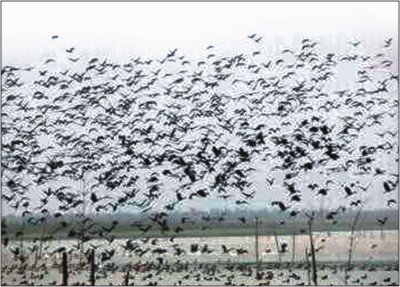 The number of migratory birds in Hakaluki Haor fell by about 50 per cent this year compared to that of last year. However the total number of birds, mainly comprising local ones, went up.
These were revealed in a survey organised by the Coastal and Wetland Bio-diversity Mana-gement Project (CWBMP) of the Department of Environment.
Arrival of migratory birds decreased in last few years as many of their natural sanctuaries were disturbed due to 'noisy fishing' (by using mechanised boats) and hunting, the survey said.
The number of migratory birds in Hakaluki Haor fell by about 50 per cent this year compared to that of last year. However the total number of birds, mainly comprising local ones, went up.
These were revealed in a survey organised by the Coastal and Wetland Bio-diversity Mana-gement Project (CWBMP) of the Department of Environment.
Arrival of migratory birds decreased in last few years as many of their natural sanctuaries were disturbed due to 'noisy fishing' (by using mechanised boats) and hunting, the survey said.
The survey was done by a team of wildlife experts including Dr. Inam Al Haque, Dr. SMA Rashid and Dr. MA Aziz. Some students from Jahangirnagar University, Chittagong University and Khulna University also took part in it.
The survey was done on February 12 and 14. Last year's survey was also done during the same period.
Zafar Siddique, Project Director of CWBMP, said a total of 51,521 birds of 42 species were sighted in the haor during this year's survey. The figure includes 18,555 migratory birds of 29 species and 32,966 of 13 local species.
Four new species were found this year. These are Falcated Duck (locally called Fuluri Hansh), Gray Leg Goose (Metey Raj Hansh), Northern Lapwing (Utturey Titi) and Common Shell Duck (Pati Chokha-Chokhi).
Around 37,520 migratory birds of 26 species and a total of 46,712 birds of 49 species were counted during last year's survey, he said.
Three species - Spotbill Duck (Metey Hansh), Comb Duck (Nakta Hansh) and Grey Headed Lapwing (Metey Matha Titi)--found last year, were not sighted this year. Grey Headed Lapwing is a rare Siberian bird and the two others are local species.
This year, the highest number of 30,262 birds of 10 species was spotted in Nagua-Loribai Beel where last year's figure was 27,486.
Hakaluki Haor comprises over 18,000 hectares of water body spread over five upazilas in greater Sylhet. It was declared an Ecologically Critical Area (ECA) in 2000 to protect its bio-diversity (Source: The Daily Star, February 26, 2007).
Hakaluki Haor sees an increase in the number of winter birds
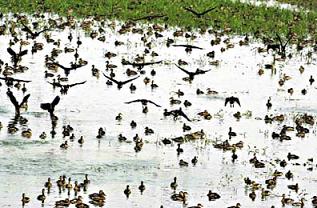 Numerous 'guest' birds (who should be actually called 'dual citizens') have flocked to Hakaluki Haor, the biggest lake in the country, and other water bodies in Moulvibazar district, delighting bird watchers and nature lovers.
Numerous 'guest' birds (who should be actually called 'dual citizens') have flocked to Hakaluki Haor, the biggest lake in the country, and other water bodies in Moulvibazar district, delighting bird watchers and nature lovers.
The aquatic birds of different species have come earlier than usual this year. There is also good news for the bird lovers - the Department of Environment has declared five water bodies including Hakaluki Haor to be 'bird sanctuaries'.
About 1,26,851 birds of 41 species have been found in the Hakaluki Haor. This figure is 2.5 times more than that found by a previous survey. A team of specialists led by a prominent ornithologist of the country, Inam Al Haque, conducted the survey at Hakaluki Haor on December 30 last year.
T
he haor is located in Moulvibazar and Sylhet districts. The 'Coastal and Wetland Bio-diversity Management Project' of the Directorate of Environment initiated this survey. Inam Al Haque also conducted another survey under the same project on February 12 and 13 last year, when a total of 51,528 aquatic birds of 42 species were found in the Hakaluki Haor.
They also found Bears Pochards and Grey-Headed Lapwings, both of which are very rare species, in this survey. Among the other species found during his survey in Hakaluki Haor were the Northern Pintail, Northern Shoveller, Graganey, Blue-winged Teal, Mallard, Gadwall, Wigeon, Common Teal, Tufted Duck, Ferruginous Pochard, Common Pochard, Ruddy Shell Duck, Cotton Pygmy Goose, Fulvous Whistling Duck, Lesser Whistling Duck, Falcated Duck, Greylag Geese, Common Shell Duck, Indian Pond Heron, Grey Heron, Cattle Egret, Great Egret, Large Egret, Little Egret, Intermediate Egret, Purple Swamp Hen, Pheasant-Tailed Jacana, Little Grebe, Great Crested Grebe, Little Cormorant, Great Cormorant, Asian Openbill, Common Coot, Pintail Snipe, Marsh Sandpiper, Little Ringed Plover, Golden Plover, Wood Sandpiper, Green Shank, Red Shank, Red-Wattled Lapwing, Brown-Headed Gull and Black-Headed Gull.
However, in another survey conducted in 20 water bodies of this Haor on February 2006, they found 46,712 aquatic birds of 49 species. But birds of 3 species like Spot Bill Duck, Comb Duck and Grey-Headed Lapwing were not found in that survey. Spot-Bill Duck and Comb Duck are local species or permanent residents of Hakaluki Haor and Grey-Headed Lapwing is a Siberian species.
According to the Kulaura office of the Department of Environment, eleven unions under six upazilas of Sylhet and Moulvibazar are adjacent to this Haor, which covers 40,000 hectares of land in Fenchuganj, Beanibazar and Golapganj upazilas in Sylhet district and Baralekha, Juri and Kulaura upazilas in Moulvibazar district. Of the total, 70 per cent of the water bodies of the haor are in Moulvibazar and 30 per cent in Sylhet.
In 1999, the Department of Environment declared Hakaluki Haor an 'Ecologically Critical Area'. Decrease of the number of aquatic trees and plants like Hijal and Koroch, and bird hunting by shooting, poisoning, or trapping were the causes of the decreasing number of birds in the haor. The Coastal and Wet Land Bio-diversity Management Project is being implemented here by the Department of Environment to preserve the environment of the water bodies (The Independent, January 27, 2008).
Can we save our loving birds?
THE TAME BIRD WAS IN A CAGE
by: Rabindranath Tagore (1861-1941)
The tame bird was in a cage, the free bird was in the forest.
They met when the time came, it was a decree of fate.
The free bird cries, "O my love, let us fly to the wood."
The cage bird whispers, "Come hither, let us both live in the cage."
Says the free bird, "Among bars, where is there room to spread one's wings?"
"Alas," cries the caged bird, "I should not know where to sit perched in the sky."
The free bird cries, "My darling, sing the songs of the woodlands."
The cage bird sings, "Sit by my side, I'll teach you the speech of the learned."
The forest bird cries, "No, ah no! songs can never be taught."
The cage bird says, "Alas for me, I know not the songs of the woodlands."
There love is intense with longing, but they never can fly wing to wing.
Through the bars of the cage they look, and vain is their wish to know each other.
They flutter their wings in yearning, and sing, "Come closer, my love!"
The free bird cries, "It cannot be, I fear the closed doors of the cage."
The cage bird whispers, "Alas, my wings are powerless and dead."
Last modified: January 27, 2008
 Guest birds no more come in flocks to the historic Nilsagor, once their safe winter abode.
Chirping of thousands of birds are not heard and big flocks in the sky are not seen. Numerous birds used to come from far away Siberia and Europe to escape chilling winter cold there. At least 10,000 birds used to come earlier but the number is less than 500 this year, its caretaker Sushil Roy told this correspondent during a visit on Tuesday. Their resting places have disappeared as most of the around 5,000 age-old fruit-bearing, medicinal and forest trees in the 53.90 acre area have been felled.
Guest birds no more come in flocks to the historic Nilsagor, once their safe winter abode.
Chirping of thousands of birds are not heard and big flocks in the sky are not seen. Numerous birds used to come from far away Siberia and Europe to escape chilling winter cold there. At least 10,000 birds used to come earlier but the number is less than 500 this year, its caretaker Sushil Roy told this correspondent during a visit on Tuesday. Their resting places have disappeared as most of the around 5,000 age-old fruit-bearing, medicinal and forest trees in the 53.90 acre area have been felled.